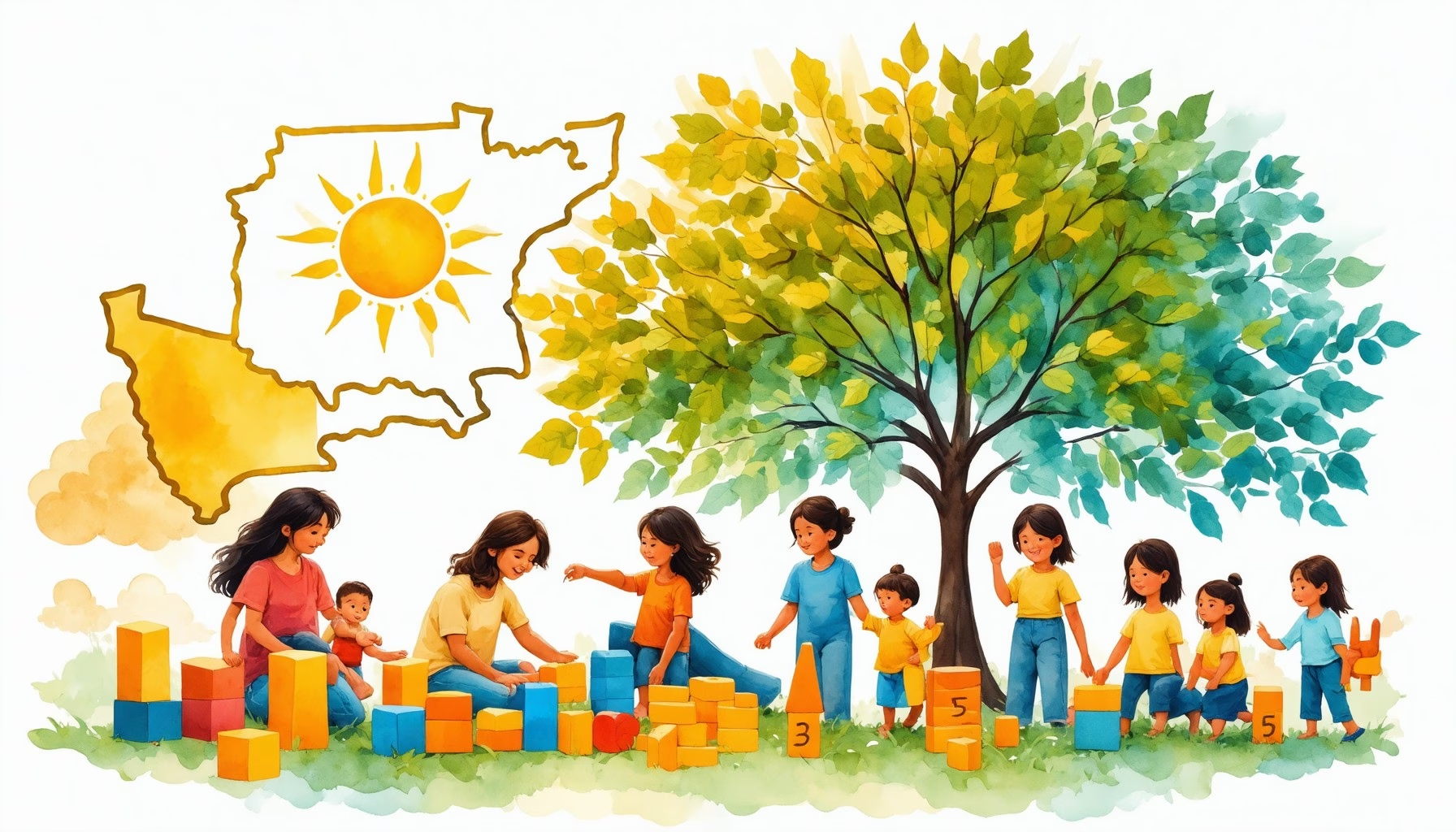Key Takeaways
- Explore daycare government help programs to alleviate childcare costs for low-income families.
- Understand state-specific daycare assistance options, including income limits and eligibility requirements.
- Access free daycare services through various government-funded programs designed for families in need.
- Learn how to apply for child care assistance in states like Washington, Colorado, Nevada, and Mississippi.
- Utilize resources like Child Care Aware for comprehensive support in securing affordable childcare.
In today’s fast-paced world, many families find themselves seeking daycare government help to ease the financial burden of childcare. Understanding the various daycare assistance programs available across states is crucial for parents looking to secure affordable care for their children. This article will guide you through essential information on assistance programs, including income limits for daycare assistance in Washington, Colorado, Nevada, and Mississippi. We will also explore options for family members providing care, the maximum claims for daycare assistance, and how low-income families can access free daycare services. Whether you’re in Texas seeking help with daycare costs or looking for daycare financial assistance in Florida, this comprehensive guide will equip you with the knowledge needed to navigate the complexities of government support for childcare. Join us as we delve into the specifics of each state’s offerings and uncover the resources available to help you manage your childcare needs effectively.
What is the income limit for daycare assistance in WA?
Understanding Income Limits for Daycare Assistance
In Washington State, families may qualify for the Child Care Subsidy if their income is at or below 60% of the State Median Income (SMI) at the time of application, or 65% of SMI during reapplication. As of the latest data, the income limits are as follows:
- For a family of two: $3,641 per month
- For a family of three: $4,498 per month
- For a family of four: $5,354 per month
These figures are based on the SMI, which is updated annually. It is essential for families to check the most current income limits and guidelines through the Washington State Department of Social and Health Services (DSHS) or the Gov Guider platform for accurate and detailed information regarding eligibility and application processes. For further assistance, families can also refer to the Child Care Aware of Washington website, which provides resources and support for accessing child care subsidies.
Overview of State Assistance for Daycare Programs
Washington State offers various daycare assistance programs aimed at supporting low-income families. These programs are designed to alleviate the financial burden of childcare costs, allowing parents to work or pursue education while ensuring their children receive quality care. The primary source of daycare assistance is the Child Care Subsidy, which helps cover a portion of daycare expenses based on family income and size.
Additionally, families can explore options such as the Working Connections Child Care program, which provides financial help with daycare costs for eligible working families. This program is crucial for those seeking help with daycare in Texas and other states, as it ensures that children are cared for in safe and nurturing environments. For more information on how to apply for daycare assistance in Florida or other states, visit the Gov Guider resource on government subsidized daycare.

Does Colorado Have Child Care Assistance?
Yes, Colorado offers child care assistance through the Colorado Child Care Assistance Program (CCCAP). This program is designed to support families who are working, actively seeking employment, or participating in training programs. Additionally, it assists families enrolled in the Colorado Works Program, providing essential child care services that enable parents to pursue self-sufficiency.
Child Care Assistance Programs in Colorado
The CCCAP is a vital resource for families in Colorado, ensuring that they have access to affordable child care. Key features of the CCCAP include:
- Eligibility Criteria: Families must meet specific income guidelines and demonstrate a need for child care to qualify for assistance. This includes working parents, those in job training, and individuals seeking employment.
- Types of Child Care Covered: The program covers various child care options, including center-based care, family child care homes, and in-home care, ensuring flexibility to meet the diverse needs of families.
- Application Process: Interested families can apply for CCCAP through their local county department of human services. The application process typically involves providing documentation of income, employment status, and child care needs.
- Funding and Support: CCCAP is funded through a combination of state and federal resources, ensuring that families receive the necessary financial support to access quality child care services.
For more detailed information about the Colorado Child Care Assistance Program, including application forms and eligibility guidelines, families can visit the Colorado Department of Human Services website or contact their local county office. This program plays a crucial role in promoting child development and supporting working families in Colorado.
How to Qualify for Child Care Assistance in Colorado
Qualifying for child care assistance in Colorado involves several steps, ensuring that families can access the support they need. Here’s how to navigate the qualification process:
- Determine Eligibility: Families must check if they meet the income limits set by the CCCAP. This typically involves providing proof of income, such as pay stubs or tax returns.
- Assess Child Care Needs: Families should evaluate their child care requirements based on their work schedules and the age of their children. This assessment helps in selecting the appropriate type of care.
- Complete the Application: Applications can be submitted online or in person at local human services offices. It’s essential to gather all necessary documentation to avoid delays.
- Follow Up: After submitting the application, families should follow up with the county office to ensure their application is being processed and to address any additional requirements.
By understanding these steps, families can effectively navigate the process of obtaining child care assistance in Colorado, ensuring they receive the necessary support to balance work and family responsibilities.
Does Nevada Have Child Care Assistance?
Yes, Nevada does offer child care assistance through the Child Care and Development Fund (CCDF), which aims to support families in accessing affordable child care while they work, attend school, or participate in job training programs. This program is crucial for enabling parents to maintain employment and pursue educational opportunities.
Overview of Child Care Assistance in Nevada
The CCDF is designed to help low-income families meet their child care needs, particularly those transitioning from public assistance. As of October 1, 2024, new applicants must meet an income threshold of 41% of the state median income (SMI), which translates to approximately $39,371 annually for a family of four. This income limit ensures that assistance is directed toward those who need it most.
Eligible child care providers include state or locally licensed facilities as well as licensed-exempt options. This encompasses family, friend, and neighbor (FFN) providers, allowing for flexibility in choosing care arrangements that best suit families’ needs.
Financial Help for Daycare in Nevada
Interested families can access the application for child care assistance on the Nevada Department of Health and Human Services (DHHS) Division of Welfare and Supportive Services (DWSS) website. The application process is straightforward and designed to facilitate access to necessary resources. For further assistance, families can contact Nevada 211, a resource that provides information on various financial assistance programs, including child care options.
For specific inquiries or personalized assistance, families can reach out to organizations such as the Children’s Cabinet or the Las Vegas Urban League, which offer support and guidance in navigating child care resources. For more detailed information, families can refer to the official Nevada DHHS website and the U.S. Department of Health & Human Services, which provide comprehensive resources on child care assistance programs.
Does Mississippi Have Child Care Assistance?
Yes, Mississippi does offer child care assistance through the Child Care Payment Program (CCPP), administered by the Mississippi Department of Human Services (MDHS). This program is designed to provide financial support to qualifying parents and guardians, helping them afford child care services while they work or pursue education.
Child Care Assistance Programs in Mississippi
The Child Care Payment Program is a vital resource for families in Mississippi, particularly those with low incomes. Key features of the program include:
- Eligibility: To qualify for assistance, families must meet specific income guidelines and demonstrate a need for child care. The program primarily supports low-income families, ensuring that they have access to safe and reliable child care options.
- Types of Child Care: Participants in the CCPP can choose from a variety of child care settings, including licensed child care centers, family child care homes, and informal care arrangements. This flexibility allows parents to select the best option that suits their child’s needs and family circumstances.
- Application Process: Interested families can apply for the CCPP through the MDHS website or by visiting local MDHS offices. The application process typically requires documentation of income, family size, and child care arrangements.
- Funding and Support: The program is funded through federal and state resources, ensuring that eligible families receive the necessary financial assistance to cover child care tuition costs. This support is crucial in promoting workforce participation and educational advancement among parents.
How to Get Assistance for Daycare in Mississippi
To access daycare assistance in Mississippi, families should follow these steps:
- Visit the MDHS Website: Start by visiting the Mississippi Department of Human Services website for comprehensive information on the Child Care Payment Program.
- Gather Required Documentation: Prepare necessary documents, including proof of income, family size, and details about your child care arrangements.
- Submit Your Application: Complete the application process online or in person at your local MDHS office. Ensure that all information is accurate to avoid delays.
- Follow Up: After submitting your application, follow up with the MDHS to check the status and provide any additional information if requested.
By providing this assistance, Mississippi aims to enhance the well-being of children and support families in achieving economic stability. For more detailed information about eligibility requirements and available resources, parents can visit the Mississippi Department of Human Services website or contact their local MDHS office.

Can my mom get paid for watching my child?
Yes, your mom can get paid for watching your child through several programs and arrangements, depending on your location and specific circumstances. Here are the key options available:
- In-Home Support Services (IHSS) Program: In California, family members, including parents, can be compensated for providing personal care services under the IHSS program. This program is designed to help individuals who need assistance with daily living activities. For more information, visit Kids’ Waivers.
- CalWORKs Child Care: This program provides financial assistance for child care to eligible families, particularly those receiving CalWORKs cash aid or to pregnant and parenting teens. The California Department of Social Services outlines eligibility criteria and application processes on their official website.
- Home and Community-Based Alternatives Program: This program allows legally responsible individuals, including parents, to be paid for waiver personal care services (WPCS) or paramedical services. More details can be found on Kids’ Waivers.
- Private Arrangement: You can agree to pay your mom directly for babysitting services. In this case, she would be classified as a household employee. Generally, you are not required to withhold FICA taxes if she is your parent, but she must report this income on her tax return. For guidance on tax implications, refer to TurboTax Support.
- Tax Considerations: While you may not need to issue a W-2 for your mom, it is important to keep accurate records of payments made for tax purposes. The IRS provides resources on household employee tax obligations.
Exploring Payment Options for Family Childcare Providers
When considering payment options for family childcare providers, it’s essential to explore various avenues that can provide financial support. Government programs can assist in offsetting costs associated with daycare. For instance, government subsidized daycare programs can offer significant help for low-income families seeking affordable childcare solutions. Additionally, programs like Child Care.gov provide resources to help families navigate available assistance.
Government Programs Supporting Family Childcare
Several government programs are designed to support families in need of childcare assistance. These programs often provide financial help for daycare costs, making it easier for families to afford quality care. For example, government assistance for low-income families can include daycare assistance, helping families manage their childcare expenses effectively. Understanding how to apply for these programs can be crucial for families looking for daycare government help.
What is the maximum amount you can claim for daycare?
Understanding the maximum amount you can claim for daycare assistance is crucial for families seeking financial help with daycare costs. The Child and Dependent Care Credit allows eligible taxpayers to claim a percentage of their qualifying daycare expenses, which can significantly alleviate the financial burden of childcare. For the tax year 2024, you can claim between 20% to 35% of your qualifying daycare expenses. The maximum amounts you can claim are $3,000 for one qualifying individual and $6,000 for two or more qualifying individuals. It’s important to note that the percentage you can claim depends on your adjusted gross income (AGI), with lower-income taxpayers eligible for a higher percentage. For comprehensive guidance on eligibility and how to apply for the credit, refer to the IRS guidelines on the Child and Dependent Care Credit.
Maximum Claims for Daycare Assistance
In addition to the Child and Dependent Care Credit, various state programs offer daycare government assistance to families in need. These programs can provide financial help for daycare in states like Texas and Florida, ensuring that low-income families have access to affordable childcare options. For instance, government subsidized daycare programs aim to reduce the cost of daycare for eligible families, making it easier to balance work and family responsibilities. Each state has its own guidelines and limits for daycare assistance, so it’s essential to check local resources for specific information.
Understanding Daycare Financial Assistance Limits
Daycare financial assistance limits vary by state and are designed to support families based on their income levels. For example, in Florida, assistance with childcare programs can provide crucial support for low-income families, helping them cover daycare costs. To get assistance for daycare, families often need to meet specific eligibility criteria, including income limits and employment status. Understanding these limits and how to apply for assistance can empower families to access the resources they need. For more information on how to get daycare vouchers in Florida, visit Child Care.gov for detailed guidance.
Free daycare for low-income families
Accessing daycare government help can significantly ease the financial burden on low-income families. Various programs are designed to provide free daycare for low-income families, ensuring that children receive quality care while parents work or pursue education. These programs are often funded by state and federal governments, aiming to support families in need.
Government Daycare Programs for Low-Income Families
Many states offer daycare assistance programs specifically for low-income families. These programs can include subsidies, vouchers, or direct funding to cover daycare costs. For instance, in Florida, the Child Care Development Fund provides financial assistance to eligible families, helping them afford quality childcare. Similarly, Texas has its own daycare assistance program that offers financial help with daycare costs through various local agencies.
To qualify for these programs, families typically need to meet certain income guidelines and provide documentation of their financial situation. It’s essential to check with local agencies or state websites for specific eligibility requirements and application processes.
How to Get Free Daycare in Florida and Other States
To obtain free daycare for low-income families, the first step is to research available programs in your state. In Florida, families can apply for assistance through the Administration for Children and Families, which oversees various childcare assistance programs. Additionally, local community organizations often provide resources and support for families seeking help with daycare.
In Texas, families can explore options like childcare assistance Texas programs, which help cover daycare costs for eligible families. It’s advisable to gather necessary documents, such as proof of income and residency, before applying. For more detailed information on how to get assistance for daycare, visit the Gov Guider page on government subsidized daycare.




